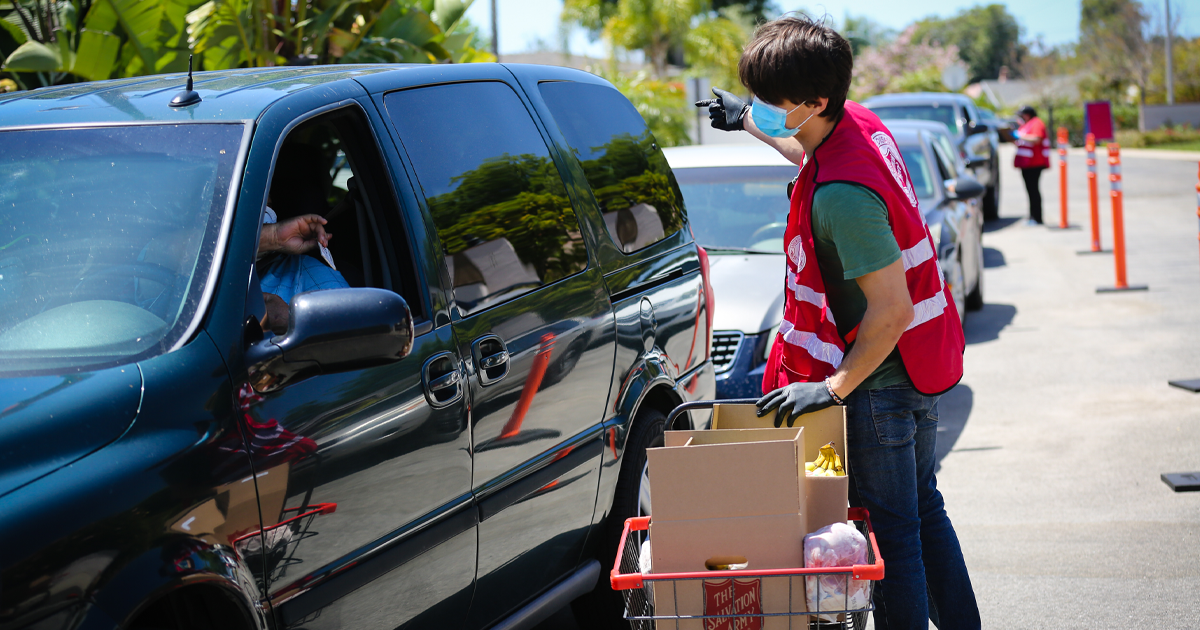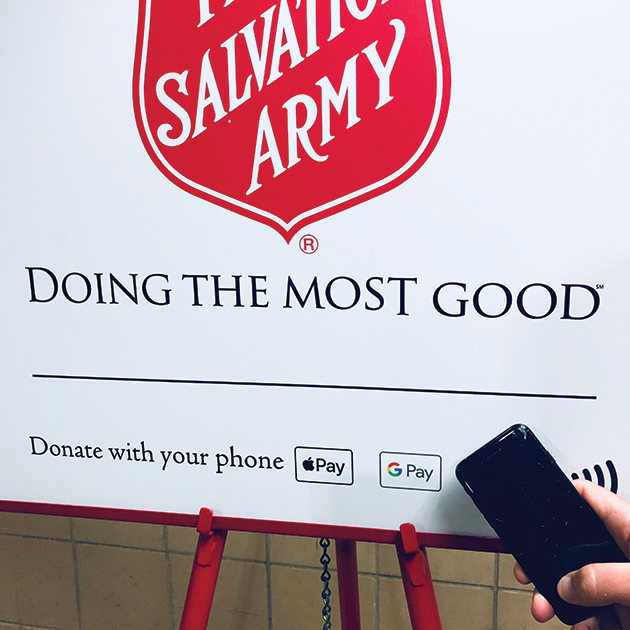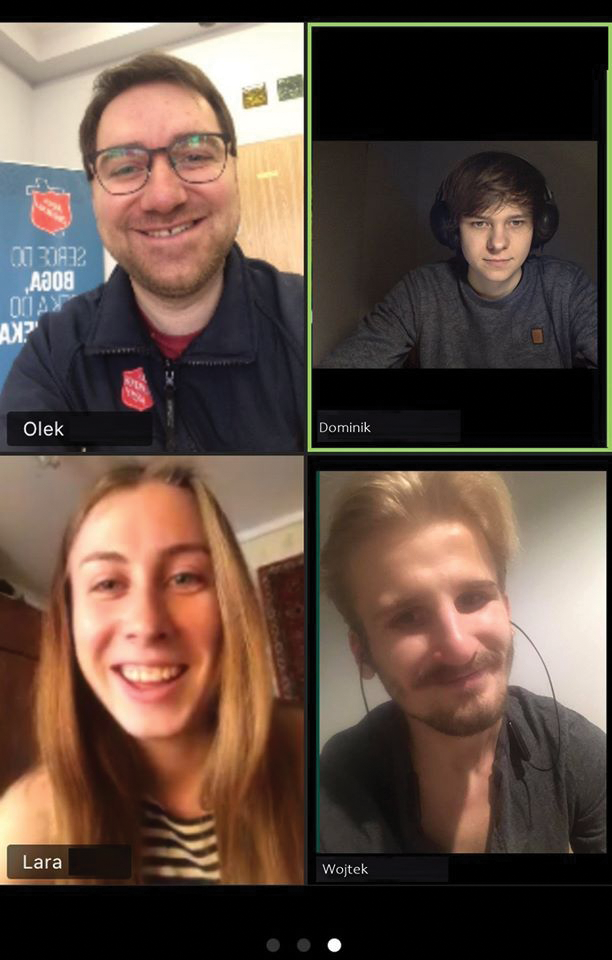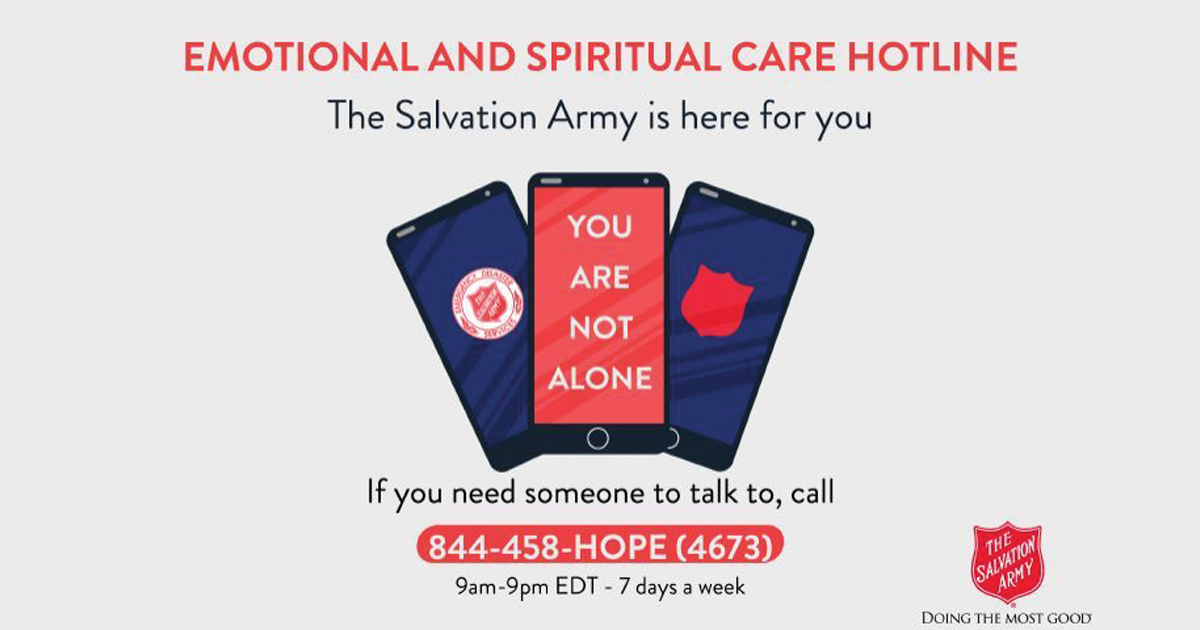Anticipating The New Normal
By request, national and territorial leaders assess the Army’s response to the crisis caused by COVID-19 and the challenges and opportunities ahead.
Time to Face Challenges, Explore Options
Pandemic. New normal. Social distancing. Overnight, it seemed, our world changed. Our daily routines upended. Some of us were deemed “essential,” others were furloughed. We began staying home and suddenly realized just how incredible our children’s teachers are.
The Salvation Army was no exception to these changes. Childcare and afterschool programs closed, as did our Family Stores (Thrift Stores). People were in need of food and we had to adapt in order to serve while physically distant. Worship services pivoted to online services. Shelters and residential facilities had many challenges to keep our residents safe. And these are just a few examples of the changes experienced in the Army’s more than 7,600 centers of operation in the United States.
As communities start to reopen, the Army is faced with many challenges. How we view and acknowledge those challenges and step up to the plate with the opportunities these challenges provide will determine the course for the future.
Financial Challenges
The financial challenges are many. Unlike usual disaster situations in which individuals outside of the affected area step up and support with donations, the coronavirus pandemic affected all areas of our country. It resulted in the closure of our Family Thrift Stores, which are the primary funding source for the Adult Rehabilitation Centers. These centers provide a safe environment for those with substance abuse problems to overcome those issues through a work therapy program. Those centers continued operating despite the lack of funding, but will customers and donors return when the store doors are opened?
And what about Christmas? The Salvation Army is most visible during the holiday season, but what will that look like this year? Will stores allow the Army to place their iconic stands and kettles outside their doors this Christmas? Will people be willing to get close enough to another person to make a donation at a kettle? How does an organization with over 100 years of this visible presence do so in an environment of online shopping and physical distancing?
Shrinking resources create a need to evaluate effectiveness of programs, staffing and ways of operating. The closure of programs (even if originally just deemed temporary) can make it very difficult to reopen.
Worship Challenges
The abrupt closure of buildings, including our worship centers, resulted in incredible innovation in keeping connected with congregations—online worship services, drive-by activities, pastoral visitations. While different, much of it was engaging and kept folks connected. As we begin worshiping again in buildings, will that engagement and innovation continue, or will we return to church as it has always been? The article by Carey Nieuwhof on disruptive church trends is a must read.
Social Services Challenges
Helping people in crisis is at the heart of what The Salvation Army does. This is seen immediately whenever there is a natural disaster and was evident during this pandemic. Immediate changes were made in our shelters and residential facilities. Food distribution processes were changed to get food to hungry Americans as quickly and safely as possible.

Our country is seeing record unemployment numbers. The Congressional Budget Office is projecting that the unemployment rate will average 10.1% in 2021 and still be at 9.5% in the final months of that year. For comparison, The Salvation Army provided services to an additional 10 million individuals during the Great Recession, so what will the needs, the requests and the numbers look like in this crisis?
It is expected that there will be a large increase in the number of evictions as the country continues to open and emergency moratoriums protecting renters expire, adding large numbers of individuals and families to the rolls of those experiencing homelessness.
These are the services that the Army typically provides. Are we ready for the influx? Are we thinking long-term, as one rent payment and a bag of food may not, and probably won’t, be enough? This may be the opportune time for Pathway of Hope to expand and implement in all Salvation Army locations. Are we committed to that model and the investment in people that it requires?
These challenges are by no means all the challenges currently facing The Salvation Army. COVID-19 has stretched us and challenged us, and now is our opportunity to respond.
Lt. Colonel Michele Matthews, National Secretary for Social Services and Public Policy.
Building on the Pathway of Hope
Across the Midwest, Salvation Army units demonstrated exceptional flexibility and service in meeting their communities’ urgent needs during the spring. In the months ahead, the USA Central Territory anticipates moving from what could be termed emergency crisis response to a recovery phase and is preparing to meet that challenge.
According to Dr. Maribeth Swanson, territorial Social Services secretary, online social service caseworker certification introduced last year and the capacity-building and collaborations which have resulted from the Pathway of Hope (POH) initiative will aid immensely in managing and meeting people’s long-term needs.
“We have learned a lot from POH on how to support families experiencing a crisis move toward increased stability and sufficiency,” says Swanson. “I think The Salvation Army is in a much better place in our capacity to implement strong long-term recovery case management, networking with other community agencies, churches and educational institutions at the local level.”
This should help enable people to access a range of resources for utility assistance, rent/mortgage assistance, childcare, housing, and emotional and spiritual care. Because of POH there is an infrastructure in place, specific personnel training and a robust client data system that can track outcomes so progress can be assessed and assistance adjusted. It is anticipated for the foreseeable future that most case management will occur virtually, and additional steps have been taken to enable this.
As social distancing and limited gatherings are expected to remain the norm for an unspecified period, it is anticipated that Salvation Army units will continue to leverage technology to provide other services and programs for their members and communities.

During this crisis, corps have adapted their ministries, availing themselves of web-based curriculum, using online platforms for live meetings like Bible studies and prayer groups, and posting Sunday services, youth character-building and music instruction and messages of encouragement on YouTube and Facebook.
Some completely new ministries have emerged as well, including one by the territorial youth department that plays into the phenomenon of Esports. Central Youth Network (CYN) Esports utilizes the popular gaming communication platform, Discord, to create a place for friendship, community and discipleship. In addition to gaming, it features weekly video devotions and an active prayer request community chat. As of April, it had 85 members.
We are finding and building ways to stay connected and make new connections in sharing the gospel of Jesus Christ like never before.
Lt. Colonel Paul Smith, Assistant Chief Secretary of the USA Central territory in Chicago
Serving in the Nation’s Hotspot
What emerged as seemingly a West Coast disaster, shifted almost overnight to the USA Eastern Territory, which became the country’s hotspot regarding the COVID–19 pandemic. New York City alone has carried the highest number of confirmed cases, rates of infection and deaths nationwide.
“The pandemic has opened everyone’s eyes,” said Bob Myers, director of Emergency Disaster Services (EDS) in the territory. “We’re burning the candle at both ends and it’s definitely taking a toll. Stress levels are high. Some of our sites have had confirmed cases. This impacts the operation with respect to losing personnel, but it also affects morale. The fear factor is high at these locations.”
Despite this unprecedented challenge to the Army’s human, material and financial resources, roughly 1,000 to 2,000 officers, retired officers, staff and volunteers daily put on their masks and gloves and get to work like never before.
“At many of the sites, people have established a steady work stream and routine,” said Myers. “Folks are working longer hours in a lot of places. In a couple of divisions, people are working six days a week. Even Saturdays are being used as a catch–up day to get ready for the next week.”
Feeding the hungry
So far, the counterattack to COVID-19 is in providing food to families in need, and emotional and spiritual care. “We’re doing a lot of food distribution,” Myers said. “We are also providing limited hot meals in certain areas. Territory wide, we’re distributing about 40,000 food boxes a week.
There are 20 to 25 meals in a box. Distribution varies depending on location. Some are drive-up, or drive–thru locations at corps facilities. Other deliveries arrive at doorsteps. The third method is door–to–door for the most vulnerable populations and to residents of senior centers and multiple apartment buildings. “At this point, there are very few people who are actually coming through the front door of the corps,” said Myers.

Comforting the distressed
At the outset, some divisions performed in–person spiritual and emotional care while exercising strict social distancing practices. As government restrictions increased, divisions instituted various technologies to accomplish virtual emotional and spiritual care sessions via phone and the internet. Outreach to staff and officers expanded to include using a national 800-number, 844 Hopeline, which was previously established in the USA Southern Territory. “This is now a nationwide resource available to the general public, providing them with someone they can talk to,” said Colonel Hugh Steele, secretary for Business Administration at territorial headquarters.
Planning the future
“With respect to the ‘new normal,’ we’re trying to wrap our heads around that idea right now,” said Myers. “We’re working closely with Social Services. Since the early days of the pandemic, we’ve been largely in an EDS–centric mode. But as we look toward recovery, we’ll shift to more of a social service–centric operation.”
Steele said organizational collaboration is the answer to the uncertainty regarding the future and short–term plans will be the most realistic for now. “It’s what’s immediate; what we face today. Until they open business and the economy starts to turn around, which is going to take some time, I don’t think we can really speak into what tomorrow will look like.”
Myers agrees, “Our hope is that when we turn the corner, reopen businesses and get back to a new normal, we’ll be able to bring our full staff back online. But the reality is that we’ll see some limitations that we are either anticipating or haven’t yet foreseen. There will be lessons learned that will come out of this. Hopefully, they will help us change things for the better.”
At the time of this writing, infection rates are down in the East and fewer COVID–19 cases are in hospitals. The Salvation Army in Ohio is carefully preparing to reopen some of its thrift stores. All eyes are watching, as in many ways this process might eventually model a nationwide strategy.
Warren Maye, Editor-in-Chief, USA Eastern territory in West Nyack, New York
Augmenting Service Delivery
The USA Southern Territory has stood in the gap in response to COVID-19 with a consistent goal of meeting human need in the name of Jesus Christ without discrimination.
Social Services
The South modified service delivery to include increasing overnight shelters to 24/7 operations. Childcare programs that had to close shifted their focus to care for the children of First Responders. Family shelters near capacity moved families to local hotel/motels to minimize the spread of infection. Other locations erected large tent shelters to accommodate increased service to homeless individuals or to allow for proper distancing between beds.
Emergency Disaster Services
Working with local and state Emergency Management, EDS staff have been monitoring the supply of PPE resources and food distribution to health workers. Partnerships have continued with major associates like Midwest Food Bank, which is providing food boxes for distribution across the nation. EDS has been working with the Adult Rehabilitation Command as cargo trucks are made available to transport food and other goods where needed. Canteens and crews have provided meals, snacks and drinks at COVID-19 testing sites on properties owned by Walmart. The Emotional & Spiritual Care Hotline (844 458-4673) originating in the Southern Territory expanded to a national service with two contact points; one offering emotional and spiritual support to callers and a second line to assist people in need of resources.
Communications
The South’s Communications Bureau has seen a significant uptick in demand for video, social media and graphics packages that equip field officers and workers to share messages of hope and encouragement, with several recorded by territorial leadership. A regular blog post with news of community engagement has appeared consistently on the national Emergency Disaster website disaster.salvationarmyusa.org.
Development
In late March, the Community Relations & Development Department held its first-ever Donor Townhall Conference Call on the organization’s response to the COVID-19 pandemic. Donors and advisory board members from across the southeastern United States were invited to attend via phone. During the call with over 11,000 listeners, several interactive opportunities materialized and valuable polling data collected through survey questions.
Program
Restrictions on group gatherings threw an extraordinary challenge at corps officers to provide virtual worship and evangelistic outreach to their congregations. This also opened opportunities to offer virtual programming to youth and children. Territorial Mission & Cultural Ministries, Music, Youth and other departments immediately began to produce and distribute resources and helpful tutorial guides to assist corps officers and staff to launch into virtual ministry through Facebook Live and other platforms. The famed Ministry Toolkit has become an even more valuable hub to store and share all this additional information. (Search for Church In A Box at ministrytoolkit.org)
Pathway of Hope
The Pathway of Hope national poverty alleviation initiative has well-positioned the Army to respond during the pandemic. Case managers have built strong relationships between clients and the corps, which allows us to support them through long term recovery. This approach allows the Army to have a deeper impact on the most vulnerable we serve—families with minor children. Corps staff engage clients remotely and conduct virtual case management sessions using Microsoft Teams.
For decades, the backbone of the nation’s disaster response system—and a hallmark of American generosity—has been its army of volunteers who race toward danger to help shelter, feed and counsel victims of hurricanes, wildfires and other calamities.
—New York Times, May 22, 2020
At our Corps and Centers
Augmented service to the community has been continual. Food has been a major priority as so many have been without a regular paycheck due to layoffs and furloughs. Children have received activities and educational projects with a biblical message. With Salvation Army run Boys & Girls Clubs closed, staff launched new digital learning strategies to engage members in their homes. Ray & Joan Kroc Centers stay in touch with their members through social media, sharing inspirational messages and fitness workouts.
Southern Territorial Chief Secretary Colonel Ralph Bukiewicz states: “The territory is taking responsible steps to adjust all expenditures, to maximize donor support throughout this season and to reinforce the trust of those who have provided resources. As we partner with our communities, the public can be confident that we are responding to all who turn to us in need.”
Christopher W. Priest, Territorial Director of Communications of the USA Southern territory in Atlanta, Georgia
As the COVID-19 disaster struck the West, the Western Territory raced into action, providing food programs and shelter services across the western U.S. to those affected by the novel coronavirus. Every Salvation Army facility and all officers and personnel became available for emergency services.
In its first month, some 970,000 meals, beverages and snacks plus 416,000 food boxes were distributed, along with 99,000 nights of lodging and 106,00 Emotional and Spiritual Care (ESC) contacts. By late May, the numbers reached astronomical proportions: Hot and cold meals reached 1,659,750, food boxes rose to 511,576 and nights of lodging provided came to 307,530.
We continue to reimagine the way we do service. For example, we have made phone charging stations available for homeless individuals who would normally charge their phone at closed locations such as coffee shops, public libraries and fast food restaurants. These phones are a lifeline so people we serve can talk to case managers, housing navigators, medical professionals and family/friends.
Adapting new methods to provide feeding services have included using school buses to deliver to children in Montana, delivering to COVID positive people in quarantine and hand delivering meals daily to 1,400 people living in encampments in San Francisco.
Local Salvation Army corps have been carrying out Sunday services in parking lots—reminiscent of old drive-in movie theatres—and using social media and other new ways to reach far beyond the walls of their corps. Soldiers provide prayer stations at food distribution sites. Some call our seniors from our 39 Silvercrest Senior Residences and corps to share a devotional thought, a prayer, assess needs and simply talk. Our facilities have become places of refuge as shelters, feeding sites and testing sites. The list goes on.
The Salvation Army must anticipate dealing with challenges in the months ahead as we fulfill our mission. We must reimagine, restructure and reset.
We must maintain efforts to reach people in their homes—such as through online worship services and Bible studies, and soldiers inviting friends to join in. We’re holding virtual town halls with donors and establishing phone lines to provide spiritual support. It’s great to see Salvationists sharing, meeting local needs, caring for the lonely, lost and hungry and asking to share a prayer.
Public awareness of our efforts has grown, and government officials, organizations and groups are realizing that this is one organization to partner with and count on to do “Mission Possible” and produce tangible results.
A time like this gives us further impetus to rely on God’s leading and His wisdom.
The Army must be ready to reset, utilizing our best and most effective ministries. We must be willing to reduce duplication in roles in corps and divisional and territorial headquarters. We need to regionalize functions where we can and work remotely where it makes sense. We must refuse to take on debt. We need to find alternative means to fund vital programs, including the Adult Rehabilitation Centers.
This is our World War I “donut girl” moment and our challenge is to be ready, respond and to bring a new icon to the world, one of a Salvation Army as the hands and feet of Jesus in a variety of innovative, creative ways, racing into the future, confronting the dangers and challenges in a new model: A church without walls. A blank canvas.
Commissioner Douglas Riley, Territorial Commander of the USA Western territory in Rancho Palas Verde, California
As Editor-in-Chief Lt. Colonel Tim Foley points out, “The COVID-19 crisis isn’t anywhere close to winding down and many are concerned about their own futures. Let’s keep our hand on the plow, forging ahead in our work and mission in life. Let’s continue to trust God to make a way for us through each step we take.”







